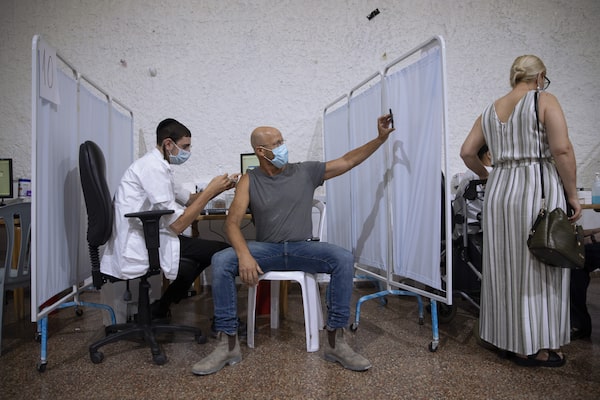
An Israeli man takes a selfie while receiving the third Pfizer-BioNTech COVID-19 vaccine from medical staff at a coronavirus vaccination center in Ramat Gan, Israel, on Aug. 30, 2021.Oded Balilty/The Associated Press
The way the COVID-19 pandemic is unfolding, we will likely all need a third dose of vaccine, eventually.
But there is no reason we should be rushing to get everyone a so-called “booster” shot at this time. (More on the language in a minute.)
In fact, there is every indication that the longer we can hold off, the better.
For now, we need to target our efforts, focusing on high-risk groups, notably elders in institutional care and some people who are immunocompromised, such as transplant and cancer patients, as the National Advisory Committee on Immunization (NACI) has wisely recommended.
The reason frail, older people need another shot is not because the vaccine doesn’t work, but because they tend to have a weaker immune response in the first place.
Almost all the cases of hospitalization and death we are hearing about in “fully” vaccinated people are in the 65-and-over demographic. That is largely because they are actually not fully vaccinated. They need a third shot.
Many scientists don’t like the common vernacular “booster.” Rather, they would like the public to consider three shots to be a normal COVID-19 vaccination regime.
Multiple doses are not uncommon for conferring protection, such as with HPV vaccination. Boosters are something else – used to bolster immunity when it is waning; for example, we should get a tetanus booster every 10 years.
The good news is that immunity to SARS-CoV-2, the virus that causes COVID-19, doesn’t seem to be waning too badly in the general population. A study by the Institute for Clinical Evaluative Studies (ICES) found that, in Ontario, the vaccinated still had 81-per-cent protection eight months after a second shot, and that it even protected against the dreaded Delta variant.
Those data do not suggest that we need a mass campaign of third shots.
It should be noted, however, that we still have a lot to learn about immunity, and how to measure it. For example, there is a lot of debate about whether being infected and recovering confers as much protection against infection as vaccination.
So far, only two countries are aggressively promoting third shots, the U.S. and Israel.
Israel is recommending that everyone over the age of 12 get three shots. It is even modifying its Green Pass so that access to public venues will be limited to those with three shots. Initial reports are that the third shots dramatically improved protection, but it’s not clear if that benefit will hold up in the long-term.
The U.S., for its part, is telling everyone over 65 and anyone with chronic health conditions, to get a third COVID-19 shot. (The third dose is actually a half-dose.) In its system, which prioritizes personal choice, a lot of younger people are also getting a “booster.”
These outliers aside, most countries are finding it difficult to justify a universal third shot campaign, both scientifically and ethically.
Canada’s situation is quite unusual. Because of early shortages, the interval between first and second shots was as long as 16 weeks for Canadians. That was controversial, but turned out to actually be good for bolstering immunity.
Similarly, because of contracts with multiple suppliers, Canada did a lot of mixing-and-matching of vaccines. That too seems to provide better immunity.
This is a rare instance where politically flailing about may actually prove beneficial to our collective health.
In the coming weeks, COVID-19 vaccines will almost certainly be approved for children between the ages of five and 11. Clearly, we should prioritize getting first shots to younger people rather than third shots to the general population. (Elders in congregate settings are another matter; they should get dibs, and they already are in many provinces.)
Let’s not forget either that of the 7.7 billion people on Earth, only 2.8 billion are fully vaccinated (meaning two doses) – just over one-third. (In Canada, it’s 73 per cent, one of the highest rates in the world.)
Mike Ryan, executive director of the health emergencies program at the World Health Organization, said universal third shot campaigns are unethical in a world where many have not received a single vaccine dose. “We’re planning to hand out extra life jackets to people who already have life jackets, while we’re leaving other people to drown without a single life jacket,” he said.
Of course, vaccinating the world and improving vaccine coverage of our domestic population are not mutually exclusive. We can, and must, do both.
We don’t need to boost inequality, especially given that, for now, the incremental benefits of the widespread embrace of third doses are not worth it.
Keep your Opinions sharp and informed. Get the Opinion newsletter. Sign up today.
 André Picard
André Picard